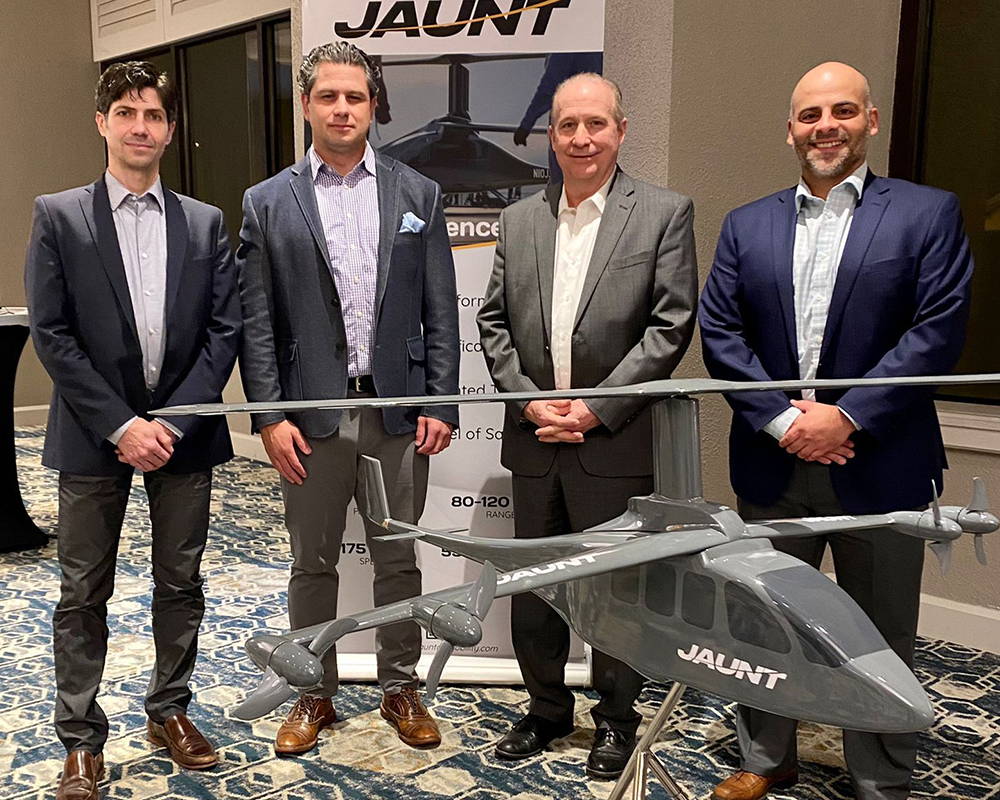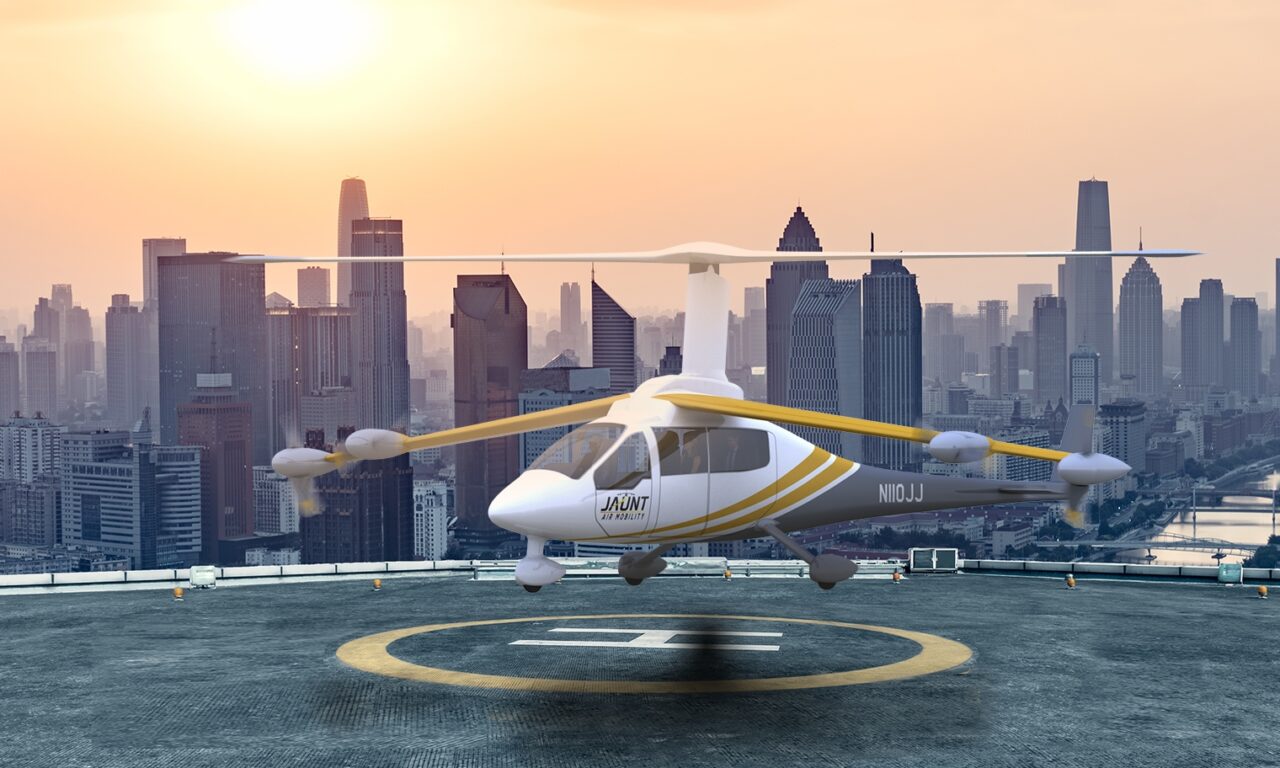Jaunt Air Mobility and Avports Partner to Advance eVTOL Integration


Jaunt Air Mobility and Avports will work together to advance the integration of eVTOL aircraft and carbon-neutral air mobility operations. (Photo: Jaunt)
Avports and Jaunt Air Mobility recently signed a Memorandum of Understanding (MOU) to coordinate in the integration of electric vertical take-off and landing (eVTOL) aircraft into the aviation ecosystem. Avports joined Jaunt’s infrastructure alliance, Access Skyways, which was created to address some of the critical challenges in urban air mobility (UAM) that may arise over the next decade. The new partnership will expand Avports’ efforts to introduce an environmentally friendly option for commuting and accelerate progress towards carbon neutrality.
The Access Skyways alliance was started just about a year and a half ago. Jaunt’s Chief Commercial Officer, Simon Briceno, explained in an interview with Avionics what Jaunt and its partners hope to achieve with Access Skyways. “As an OEM of an eVTOL, we realized very quickly that, in talking with potential customers, there were some areas of the operations that really needed the expertise from other organizations.” They particularly saw the need for expertise related to UAM infrastructure. In order for eVTOL aircraft to begin successful commercial operations and integrate into the existing ecosystem, operators will need to be able to charge the vehicles frequently and efficiently.
Jaunt reached out to organizations that were experienced in the infrastructure space, including BAE Systems, Price Systems, and PS&S—which had experience in designing vertiports as well as partnering with Uber Elevate. They began talking with Avports because of the company’s experience in managing existing airport operations. “These organizations come together and bring the experience and expertise that we need to help our customers—existing aviation operators, part 135 operators, or future eVTOL operators—to address some of those challenges,” Briceno commented.

Pictured from left to right are Arturo Garcia, Avports COO; Jorge Roberts, Avports CEO, Martin Peryea, Jaunt CEO; and Simon Briceno, Jaunt’s Chief Commercial Officer. (Photo: Jaunt)
Arturo Garcia, Chief Operating Officer at Avports, also shared some perspectives on their contribution to the Access Skyways alliance. For the last five years, he said, it has been clear that eVTOL flight is a main part of the developing advanced air mobility (AAM) industry, and coordination and understanding will be integral to the successful implementation in the coming years.
He remarked that eVTOL aircraft have evolved very rapidly to meet the demand for sustainable flight. “We have new opportunities for ground infrastructure, such as vertiports. That is something we have been very involved with, along with the Jaunt team: working to facilitate that integration into airports,” said Garcia. He also highlighted Avports’ expertise in specific aspects of ground infrastructure such as permits, public acceptance, and interaction with the communities.
Jaunt’s Simon Briceno noted that the company takes a very realistic approach to planning and implementing initial operations. “We do not intend to need any new infrastructure for landing/take-off facilities on day one of operations,” he said. There is a lot of existing infrastructure, including over 5,000 airports in the U.S. used for general aviation. In the near-term, Briceno explained, more than 90% of the key elements that Jaunt will need to begin operations are already in place—mainly under-utilized airports and heliports near large cities—based on their analysis and modeling of ridership demand. “Our aircraft will be flying in today’s airspace under today’s rules,” he commented.

Jaunt and Avports both prioritize sustainability and environmentally-friendly integration of eVTOL aircraft into the existing airspace. (Photo: Jaunt)
Jaunt’s eVTOL aircraft, pictured above, takes off and lands like a helicopter, and it transitions to forward flight like a traditional fixed-wing aircraft.
When considering direct costs for operating an aircraft, Briceno said, Jaunt is able to significantly reduce two components: the cost of fuel itself and maintenance. Because eVTOL aircraft have fewer moving parts and less complex systems, “we’re able to flow down those savings in direct operating costs to ticket price,” he explained. Additionally, as operations ramp up, the cost for customers will decrease. Jaunt’s priorities include sustainable power generation as well as offering an affordable method of transportation.
One of Avports’ priorities in recent years has also been sustainability. Arturo Garcia emphasized the importance of having the right strategy in place as they replace existing aircraft with low-emission or zero-emission alternatives over time. Part of that strategy will include providing power that is environmentally friendly and renewable. This could include installing photovoltaic solar panels at airports, said Garcia, or “creating additional [methods for] providing thermal power—using geothermal strategies including hydrogen- and fuel cell-operated vehicles and tools in order to provide that zero-emission framework for overall operations.”
Another important factor for electric aircraft is having additional resilience from an external power supply to recharge their batteries. A reliable power source will be necessary, and will ideally be produced as sustainably and efficiently as possible. Continuity of power will also be important for electric aircraft—making sure that operations and services are not interrupted due to older existing infrastructure or extreme weather.
The post Jaunt Air Mobility and Avports Partner to Advance eVTOL Integration appeared first on Aviation Today.
—————
Boost Internet Speed–
Free Business Hosting–
Free Email Account–
Dropcatch–
Free Secure Email–
Secure Email–
Cheap VOIP Calls–
Free Hosting–
Boost Inflight Wifi–
Premium Domains–
Free Domains






